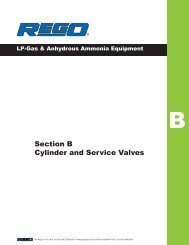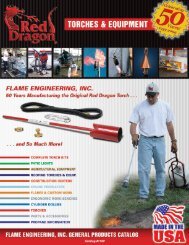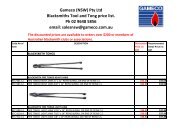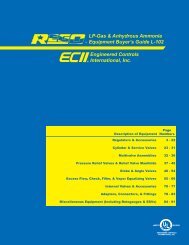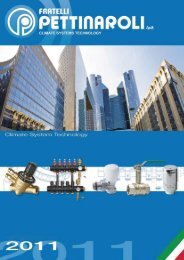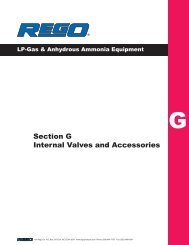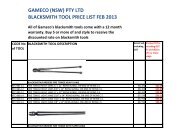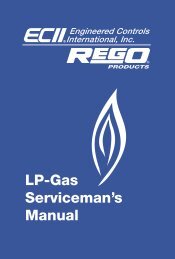Repair Kits Available By Part Number Section 2 Page - GAMECO
Repair Kits Available By Part Number Section 2 Page - GAMECO
Repair Kits Available By Part Number Section 2 Page - GAMECO
Create successful ePaper yourself
Turn your PDF publications into a flip-book with our unique Google optimized e-Paper software.
WARNING: All gas MUST be evacuated from the system<br />
before starting repairs. Follow instructions carefully.<br />
This replacement kit can be used to convert from standard<br />
style bonnets to MultiBonnets ® in the following series of<br />
RegO ® valves ONLY.<br />
6532A 7556VR 8593A<br />
6533A G8475V 9101C<br />
6542A G8475W 9101D<br />
6543A 8555D 9300Y<br />
Do not attempt to convert any other bonnet or valve.<br />
WARNING: Installation, disassembly, repair and maintenance<br />
must be performed only by qualified personnel.<br />
All gas MUST be evacuated from the system before starting<br />
repairs.<br />
Installation, usage and maintenance of this product must be in<br />
compliance with all Engineered Controls International, Inc. instructions<br />
as well as requirements and provisions of NFPA #54, NFPA<br />
#58, DOT, ANSI, all applicable federal, state, provincial and local<br />
standards, codes, regulations and laws.<br />
Inspection and maintenance on a periodic basis is essential.<br />
Be sure all instructions are read and understood before installation,<br />
operation and maintenance. These instructions must be<br />
passed along to the end user of the product.<br />
CAUTION: Contact or inhalation of liquid propane, ammonia and<br />
their vapors can cause serious injury or death! NH3 and LP-Gas<br />
must be released outdoors in air currents that will insure dispersion<br />
to prevent exposure to people and livestock. LP-Gas must be kept<br />
far enough from any open flame or other source of ignition to<br />
prevent fire or explosion! LP-Gas is heavier than air and may not<br />
disperse or evaporate rapidly if released in still air.<br />
Disassembly and <strong>Repair</strong> Procedure<br />
CAUTION: READ THROUGH ALL OF THESE INSTRUCTIONS,<br />
INCLUDING THE NOTICE AND WARNINGS ON THE BACK OF THIS<br />
SHEET, BEFORE BEGINNING ANY DISASSEMBLY OR REPAIR.<br />
NOTE: <strong>Repair</strong>s must be performed in a clean area. Hands, clothing,<br />
tools and work area must be completely free of oil, grease and foreign<br />
matter to prevent contamination of component parts and valves.<br />
A. Disassembly<br />
1. EVACUATE ALL GAS FROM THE SYSTEM BEFORE ANY<br />
DISASSEMBLY OR REPAIR. Turn handwheel counterclockwise<br />
as far as it will go to release any gas remaining in the<br />
container.<br />
CAUTION: Do not apply force after valve is fully open.<br />
2. Remove entire bonnet assembly from the valve body by turning<br />
clockwise using a 13 /16" wrench that can develop at least 800 in/lbs.<br />
torque. Discard entire assembly, including handwheel and selftapping<br />
screw.<br />
NOTE: Bonnet assembly has left hand threads, indicated by notches in<br />
the hex edge.<br />
3. Inspect valve body and clean if necessary. Be sure interior is free of<br />
dirt, residue, and foreign particles. Be sure assembly is in good<br />
repair.<br />
CAUTION: Do not SCRATCH or MAR seat area in valve body.<br />
19104-50 MultiBonnet ®<br />
Assembly for Larger Bonnet<br />
Style MultiValves ® and<br />
Service Valves<br />
B. Reassembly<br />
NOTE: Before beginning reassembly, make sure MultiBonnet ®<br />
nameplate is threaded completely onto new MultiBonnet ®<br />
assembly.<br />
1. Thread new MultiBonnet ® assembly into the valve body counterclockwise<br />
and tighten to 450-500 in/lbs. torque using a suitable<br />
13<br />
/16" wrench.<br />
NOTE: To prevent loosening of the valve body from cylinder, hold the<br />
body with a second wrench while installing bonnet. Be sure to use the<br />
lower wrenching flats when installing the bonnet assembly.<br />
2. Assemble new handwheel to valve stem and secure with new selftapping<br />
screw. Hold handwheel and tighten firmly with a screwdriver.<br />
3. Turn handwheel fully clockwise to close valve.<br />
4. Check valve for proper operation by cycling 1 /4 to 1 /2 turn in a<br />
clockwise and counterclockwise direction. Close valve, pressurize<br />
system, and check all seal points for leaks by applying a high quality<br />
leak detection solution.<br />
MultiBonnet ® Assembly<br />
MultiBonnet ®<br />
Nameplate<br />
Upper Packing Assembly<br />
3<br />
/4" wrenching flats<br />
Lower Hex <strong>Section</strong><br />
13<br />
/16" wrenching flats<br />
Standard Style Bonnets<br />
Cannot be converted using the 19104-50<br />
Self Tapping<br />
Screw<br />
Handwheel



